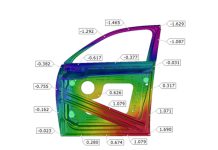During the past 20 years, stamping simulation has brought tremendous change to the way stamping processes are defined and validated, stamping tools are designed and built, and stampings are produced. Without state-of-the-art simulation tools, today’s complex stampings using high-tech sheet metal materials could never be engineered and produced to meet ever-shorter vehicle development time lines. Imagine what the availability of similarly powerful simulation capabilities would mean for engineering hemmed subassemblies!
Today, BiW (Body in white) planners and process engineers have to master the complex interactions between dimensional and surface quality of the individual stampings and the feasibility and quality targets of the hemmed assembly — without the help of up-front and detailed process simulation results. It is, for example, not at all certain that a hemmed subassembly will meet its dimensional specifications even if all stampings in the assembly meet their individual dimensional specifications. And it is not at all clear which measures are most effective to bring the hemmed assembly into spec, i.e., which of the individual parts should be modified in what way to achieve the desired assembly result. Too numerous are the parameters influencing the final assembly result and too complex the involved stamping and hemming processes.
Corrective to the hemming process often need to focus on the shape and geometry of the flanged part — leading to modifications of the trim line (i.e., the trim dies) and possibly even of the draw die geometry or blank dimensions. Furthermore, modifications interact with each other, making the result very difficult to predict. Since — without up-front analysis and validation in the virtual state — these modification requirements become evident very late in the process time line, the current process is a complex and interruptive workflow with obvious disadvantages. In addition, experiences gathered with one particular assembly may not necessarily yield relevant suggestions for correcting another. To master this complexity and to shorten tryout time lines, manufacturers have responded by creating dedicated teams working hand in hand with involved in-house departments and suppliers – i.e., stamping operations and process engineering teams as well as BiW-specialists — in order to assess the feasibility and anticipated quality of the assembly as early as possible.
Hemming process simulation capabilities on par with the evolutionary state of stamping simulation would mean, for example, that as soon as initial single-part geometry data are available, the BiW planning process would simultaneously involve the creation of virtual conceptual layouts of hemming processes and the necessary hardware. In a few initial runs, the software would indicate specific tool geometries, hemming process sequences, travel directions, travel paths, and speeds — initially without considering the forming history of the individual stampings — allowing a very early definition and validation of the hemming process intent.
This subsequently would lead to targeting or even completely avoiding corrective actions carried out by the hemming device designer in the form of redesign tasks and tryout loops later on. Additionally, the feasibility of the individual part geometries w.r.t. the assembly process may be assessed and part change requests formulated and validated at a very early stage.

Simulation of a table-top hemming process
In an extended virtual dashboard, hemming failures such as wrinkles and splits at free edges and corners, springback of the hemmed subassembly or hem thickness, roll-in, and deviations are evaluated easily and quickly with regard to necessary modification of the single part, process, or hemming device design. Therefore, in many ways, the application of such software would lead to substantial increases in quality and process transparency and to decreases in costs and lead-times. Finally, this would lead to a reliable prediction of technical solutions and therefore to a more accurate forecast of investments for upcoming car projects.
Now just dreaming about a better future involving such improvements of the hemming engineering process would certainly not make a good AutoForm blog entry. Many of our readers may not be aware that many of the processes imagined in the vision outlined above are already available today. Detailed hemming simulations are already available at AutoForm including use cases requiring part geometry data with and without forming history of the individual panels.
In the first case, planning-relevant data are generated in an early phase by setting up basic models of the assembly process using part geometry only. These preliminary results allow basic decisions regarding process intent leading to an approximate assessment of process complexity, throughput capacity, and logistics requirements as well as the number of devices and required shop-floor space. Different types of hemming tool shapes and their working directions/angles may be easily evaluated, and part geometry may be assessed including a valid trim line, for example. This early process analysis is sufficiently accurate to generate valuable process and engineering input data for the planning and design of the hemming devices.
In the second case, the hemming simulation – now including the forming history of the individual stampings – allows for a far more detailed analysis, making use of preceding simulation steps like forming and trimming. Starting from the already existing hemming simulation model built earlier, the forming histories of the individual parts are added along with available process refinements and modifications. The consolidated analysis allows a detailed assessment of all hemming-related issues to be anticipated — in roll hemming, die hemming, or tabletop hemming – as well as advanced analyses such as the springback behavior of the assembly using various clamping strategies.

Springback after Hemming
These new hemming process analysis capabilities may be harnessed by viewing the hemming validation as an extension of the regular stamping process simulation – placing it into the hands of a specialist already familiar with the simulation of sheet metal forming processes. Or, the hemming process simulation and validation are taken care of by specialist BiW teams using AutoForm’s data exchange capabilities. In this way, the software supports the workflow of BiW planning processes in different OEM-departments or even with responsibilities distributed between OEM’s and supplier companies.
So while real-life simulation for hemming processes certainly has not been around for as long as stamping process simulation, it has taken giant leaps in the recent past. And — by leveraging simulation technology already proven in the field of stamping simulation — it got a running start. While there is still some catching up to do, hemming simulation today answers most of the important questions regarding hemming process planning and engineering – leading to avoidance of planning errors, shortening engineering and lead-times, and cutting costs, benefits that stamping process engineers the world over are already relying on in their daily work.
One of AutoForm’s presentation highlights at the EuroBLECH 2016 in Hannover, Germany, in October 2016 was the introduction of this exciting new technology to customers and other interested companies. Further information dedicated to hemming simulation may be obtained at: http://www.autoform.com/en/hemming.html














Hey guys,
many thanks for your blog posts – always informative and exciting to read!
What do you think would be the future of the whole workflow of the assembly process and how far would the AI go? The Voice Control is spreading more and more, especially in warehouses. I can imagine that this could be applicable also to the automotive industry…
Best regards,
Chris